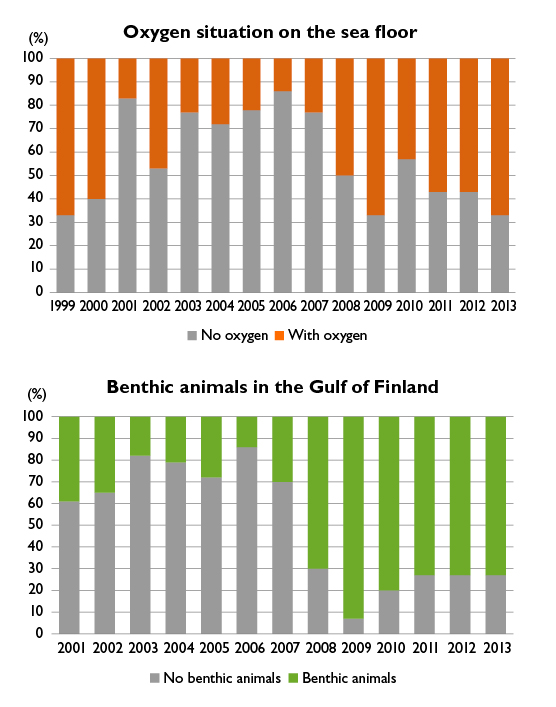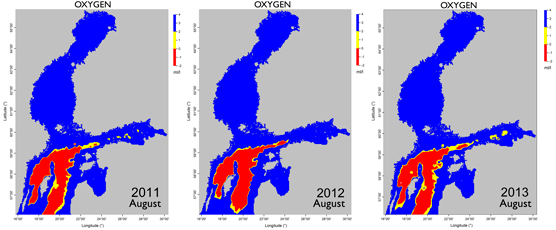Press release 2013-09-19 at 14:02
The oxygen situation on deep-sea floors, in open seas in the Gulf of Finland, has deteriorated compared to last year. Results obtained during an expedition by the research vessel Aranda in early summer shows an increase in salinity stratification in the Gulf of Finland, which has weakened the oxygen situation. At these sites, zoobenthic communities had also declined compared to last year. During the expedition in August, water layers close to the sea floor were found to be anoxic at these same sites. Hydrogen sulphide was found at sites on the Estonian side of the Gulf.
In the Gulf of Finland, phosphorus levels in the water layers close to the sea floor increased compared to last year, at sites at which oxygen levels had fallen. High phosphorus levels were measured in the central parts of the Gulf of Finland, in particular, and compared to the general level over the last ten years. However, phosphorus levels in the Gulf of Finland were generally lower than the record levels measured at the beginning and middle of the last decade.
The oxygen situation and nutrient levels in the deep water areas of the Gulf of Finland studied during the Aranda cruise are significantly influenced by the intermittent inflow of low-oxygen deep water from the Baltic Sea’s main basin into the Gulf of Finland.
The following results are from the early and late summer expeditions of the R/V Aranda, one of the two research vessels of the Finnish Environment Institute.

Oxygen levels from Gotland to the Gulf of Finland in August 2011–2013

Oxygen levels from Gotland to the Bothnian Bay in 2011–2013
No significant changes in the status of the Gulf of Finland’s coastal waters
The weakened oxygen situation in deep water areas of the Gulf of Finland was also apparent at the observation sites of the Muikku, the Finnish Environment Institute’s other research vessel. On the whole, the condition of sea floors and zoobenthic communities in the Gulf of Finland’s coastal waters were similar to last year. Although zoobenthic communities are moderately abundant in outer archipelago areas, in many places in the Gulf of Finland they still comprise of only a few species. As in previous years, most sea floors in poor condition were located in the eastern and western reaches of the inner archipelago.
In August, algae levels in the Gulf of Finland were similar to last year. In the long term, however, positive development has continued. Average algae levels in July and August are now clearly lower than only a decade ago. The clearest decline can be seen in the eastern reaches of the sea area.
In recent years in the Archipelago Sea, algae levels have stopped increasing on the peak levels observed in the early 2000s. However, no decline can be observed similar to that occurring in the Gulf of Finland. Almost without exception, the oxygen situation was good on sea floors in the southern reaches of the Archipelago Sea, and their zoobenthic communities were abundant. However, there are still areas where the sea-floor oxygen situation is only reasonable or poor, in the inner reaches of the sea area.

Saltier seawater from the main basin to the Åland Sea and the Bothnian Bay
During winter 2012–2013, saltier seawater streamed in from the main basin of the Baltic Sea into the Åland Sea basin, and partly into the Bothnian Sea. In August, oxygen levels in the Åland Sea were lower than in August last year, but still reasonable. Oxygen levels and the condition of zoobenthic communities in the Bothnian Sea and the Bothnian Bay remain healthy.
In summer 2013, blue-green algae were the most abundant algal group found in phytoplankton in open sea areas, both in the main basin of the Baltic Sea and in the Bothnian Sea. However, their abundance was lower than the average abundance over the last ten years. In the Bothnian Bay, green algae were dominant.

Oxygen levels close to the sea floor in the Baltic Sea in August 2011–2013
Analysis methods compared to intensify cooperation
During the Aranda’s expedition, a study was also carried out to compared analysis methods used in marine chemistry and biology in Finland and Russia. Together with Russian researchers, a large number of samples were taken. These samples will be analysed in three institutes in Russia and at the Finnish Environment Institute in Finland. The study is an important step towards joint research projects and shared use of data relating to the Gulf of Finland Year 2014.
Paint fragments, ash and plastic litter in the seas
In addition, the suitability of various methods for collecting microlitter from the sea was studied, in cooperation with Swedish researchers on R/V Aranda. In the preliminary analysis, common types of litter identified included paint fragments from vessels, fly ash and various small plastic items. The amount of fibre from clothes was not assessed in this study. More detailed results will be obtained later.
On their expeditions in early and late summer, the Aranda and Muikku, the research vessels of the Finnish Environment Institute, studied the oxygen and nutrient situation, plankton organisms and zoobenthic communities in the Gulf of Finland, the Baltic Proper, the Archipelago Sea and the Bothnian Bay.
More information:
Aranda
Gulf of Bothnia and Baltic Sea Proper:
Leader of the cruise, Senior Researcher Pekka Kotilainen
Finnish Environment Institute
firstname.lastname@ymparisto.fi
Tel. +358 400 1485 20
Gulf of Finland:
Leader of the cruise, Senior Research Scientist Maiju Lehtiniemi
Finnish Environment Institute
firstname.lastname@ymparisto.fi
Tel. +358 40 7255 085
Microlitter:
Researcher Outi Setälä, SYKE
firstname.lastname@ymparisto.fi
puh. +358 400 437120
Benthic animals
Senior Research Scientist Samuli Korpinen, SYKE
firstname.lastname@ymparisto.fi
Tel. +358 40 661 8977
Muikku
Leader of the cruise, Senior Research Scientist Seppo Knuuttila
Finnish Environment Institute
firstname.lastname@ymparisto.fi
Tel. +358 40 7609 232
Communication
Web Editor-in-chief Aira Saloniemi, SYKE Communications
firstname.lastname@ymparisto.fi
Tel. +358 400 1488 75
Photos for media
Oxygen levels close to the sea floor in the Baltic Sea in August 2011–2013
Oxygen levels from Gotland to the Gulf of Finland in August 2011–2013
Oxygen levels from Gotland to the Bothnian Bay in 2011–2013